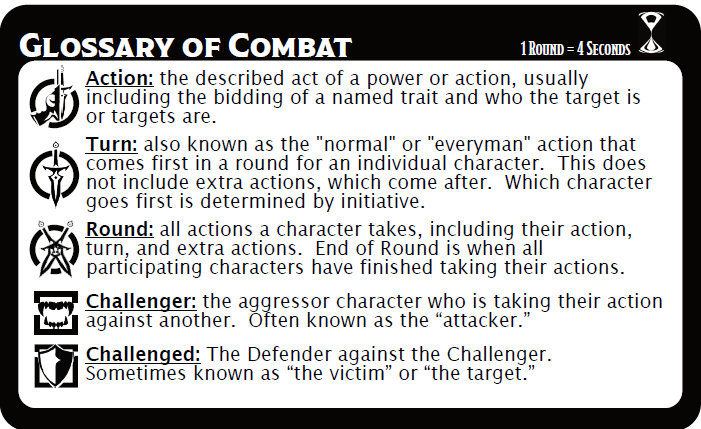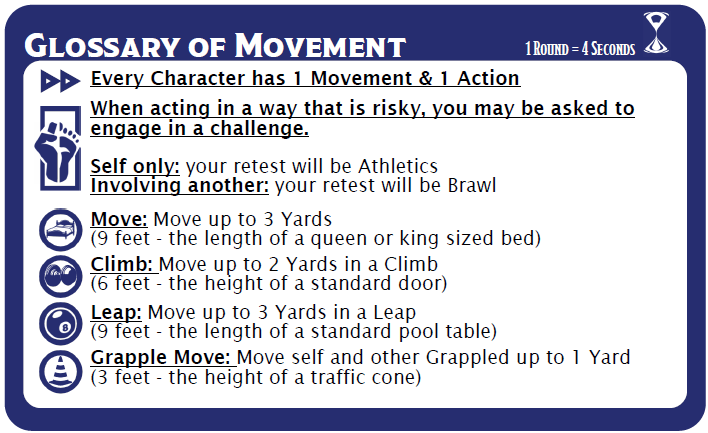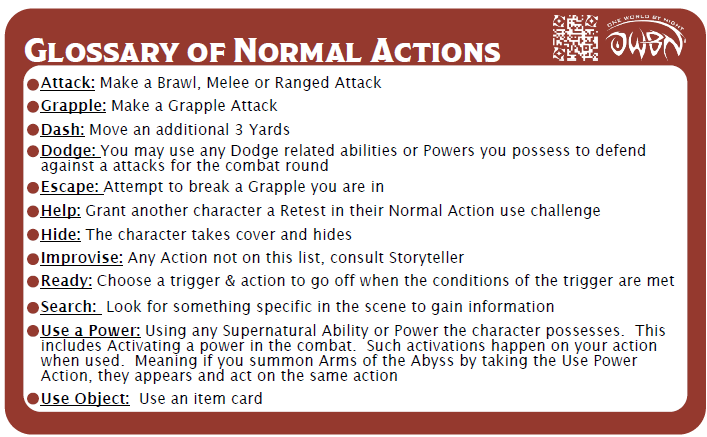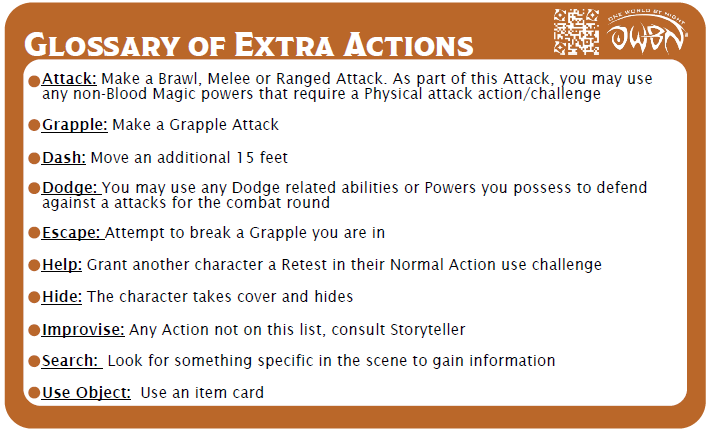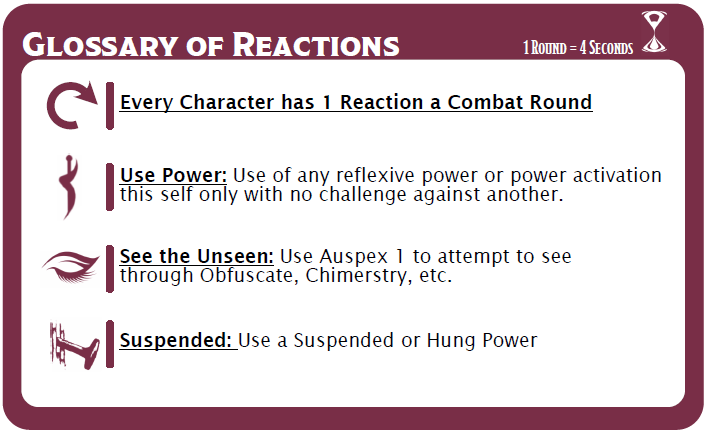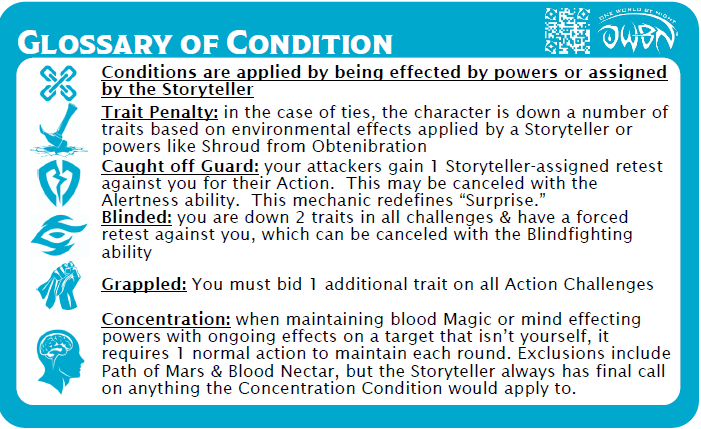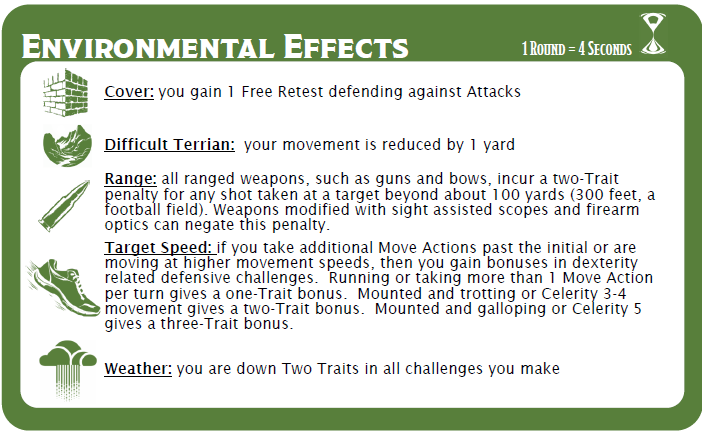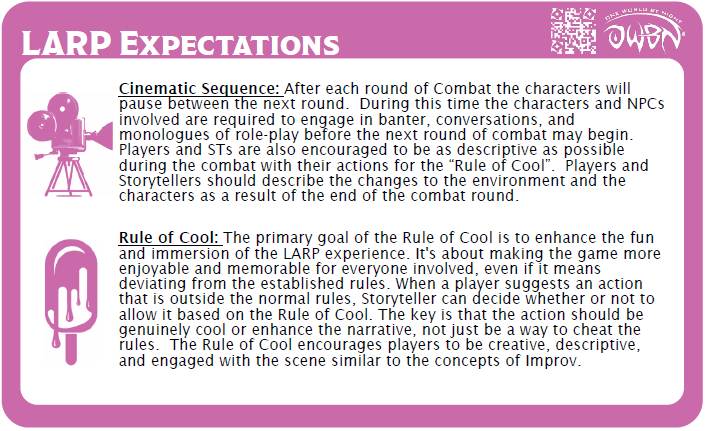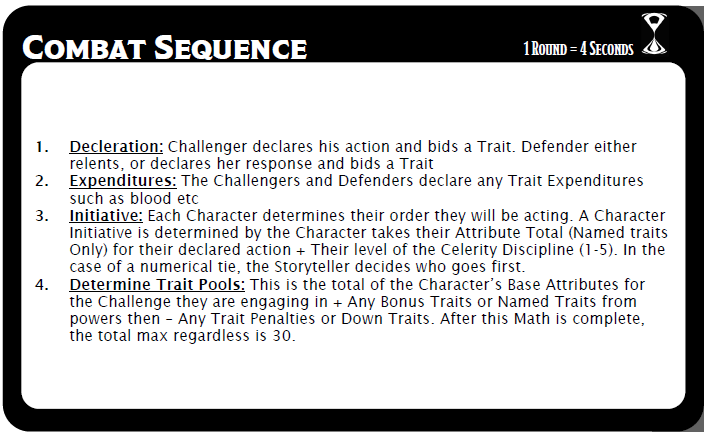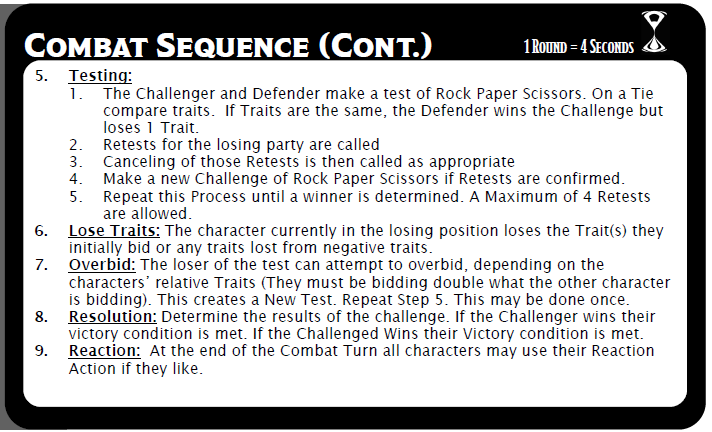Combat: Difference between revisions
Jump to navigation
Jump to search
No edit summary |
|||
| (5 intermediate revisions by the same user not shown) | |||
| Line 1: | Line 1: | ||
[[Image:Glossary of combat 1.png|left]] | [[Image:Glossary of combat 1.png|left]] | ||
[[Image:Glossary of movement.png|left]] | [[Image:Glossary of movement.png|left]] | ||
| Line 403: | Line 315: | ||
''Text Version'' | |||
| Line 490: | Line 404: | ||
==Complications== | ==Complications== | ||
*Line of Sight: Unless a power or ability specifies otherwise in it, it requires Line of Sight to use on another character. Line of Sight is defined as the ability to see the target. | *'''Line of Sight:''' Unless a power or ability specifies otherwise in it, it requires Line of Sight to use on another character. Line of Sight is defined as the ability to see the target. | ||
*Fair Escape: Characters with the Fair Escape Condition are allowed to leave the combat scene. This Condition can be gained in the following ways. | *'''Fair Escape:''' Characters with the Fair Escape Condition are allowed to leave the combat scene. This Condition can be gained in the following ways. | ||
**Powers or abilities that allow the character leave the scene. Such as, but not limited to, teleportation or superior speed/movement | **Powers or abilities that allow the character leave the scene. Such as, but not limited to, teleportation or superior speed/movement | ||
**Before any Declaration is made, a character may declare the fair escape condition and leave the scene. | **Before any Declaration is made, a character may declare the fair escape condition and leave the scene. | ||
*Carrier Attacks: A Carrier Attacks is defined as any power or ability that has detrimental effect against another character. A Character may only use 1 Carrier Attack per action they have. | *'''Carrier Attacks:''' A Carrier Attacks is defined as any power or ability that has detrimental effect against another character. A Character may only use 1 Carrier Attack per action they have. | ||
*Order of Damage Applied: is always to armor (including supernatural forms) first, prior to being resisted with Fortitude or similar powers. You may not use powers to protect armor. | *'''Order of Damage Applied:''' is always to armor (including supernatural forms) first, prior to being resisted with Fortitude or similar powers. You may not use powers to protect armor. | ||
*Feeding During Combat: You must establish a Grapple on a character with a contested Physical Challenge retested with Brawl. On your next action you may start to feed. A character may only take up to 3 blood traits a round in combat from a target. | *'''Feeding During Combat:''' You must establish a Grapple on a character with a contested Physical Challenge retested with Brawl. On your next action you may start to feed. A character may only take up to 3 blood traits a round in combat from a target. | ||
*NPC Combat Sheets: Some NPCs in Kings of New York do not have normal Vampire sheets. They will have specialized Combat Sheets created by the Staff. These sheets do not have things like Aegis and instead have a large number of Health Levels. They will also have special mechanics to better represent the NPCs needed that are unique to each. NPC Combat Sheets may also have multiple actions which the Storyteller can take at varying points of the combat outside the normal flow of Combat. The purpose of this is to help make every PC in a fight with these NPCs matter and create or a dynamic and dramatic fight for the player characters. | *'''Abilities:''' Abilities add Bonus Traits equal to their permanent level to all relevant challenges you make. You may only ever apply 1 ability in Bonus Traits to a challenge. | ||
*'''NPC Combat Sheets:''' Some NPCs in Kings of New York do not have normal Vampire sheets. They will have specialized Combat Sheets created by the Staff. These sheets do not have things like Aegis and instead have a large number of Health Levels. They will also have special mechanics to better represent the NPCs needed that are unique to each. NPC Combat Sheets may also have multiple actions which the Storyteller can take at varying points of the combat outside the normal flow of Combat. The purpose of this is to help make every PC in a fight with these NPCs matter and create or a dynamic and dramatic fight for the player characters. | |||
==Narrative Combat== | |||
For the ease of play and Discord combat the storyteller may invoke the Narrative combat rule. This rule is only ever be used in PVE situations. When invoked the rules combat change to as follows: | |||
*'''Initiative:''' This equals your Total Traits bid in the challenge you intend to throw and your levels of celerity 1-5 to gain a number total. This is your Initiative number. Players may decide who acts in what order. | |||
*'''Multiple Actions:''' Characters get 1 Action a round in combat. If they succeed in their normal action, all subsequent Additional Actions are considered to have automatically succeeded. HOWEVER, Additional actions may ONLY do damage. | |||
*'''Challenges:''' You will roll 1d3 in Discord. A 1 means a win, 2 means a tie, 3 means a loss | |||
*'''Difficulty:''' The Storyteller will tell you the difficulty of the Challenge, this in case you roll a 2 in which case you must compare your trait totals for your action to the difficulty number set by the Storyteller. The Storyteller will also tell you the number of Successes you need on the roll of dice to succeed. This represents the Retests of the NPC. | |||
*'''Retests:''' Determine the number of retests you would have in the challenge for the action you have chosen. When rolling for Challenge resolution roll a number of D3s equal to 1+ your number of retests. Keep track of wins/tie/loses. This retests are still lost as normal; so be sure to keep track of that as well in regards to this system when rolling further challenges. | |||
*'''Rule of Cool:''' When engaged in narrative combat, you the player, should be as descriptive as possible with your actions. The more depth and thought you put into what your character is doing, the more reward you gain. As a result, the Storyteller may award you 1-3 extra Retests on your action, depending on how descriptive you have been. | |||
Latest revision as of 10:07, 1 August 2025
Text Version
Glossary of Combat
- Action: The described act of a power or action, usually including the bidding of a named trait and who the target is or targets are.
- Turn: Also known as the "normal" or "everyman" action that comes first in a round for an individual character. Which character goes first is determined by initiative.
- Round: All actions a character takes, including their action, turn, and extra actions. End of Round is when all participating characters have finished their actions.
- Challenger: The aggressor character who is taking their action against another. Often known as the "attacker"
- Challenged: The Defender against the Challengers. Sometimes known as "the victim" or "the target"
Glossary of Movement
- Every Character has 1 Movement & 1 Action
- When engaging in a way that is risky, you may be asked to engage in a challenge.
- Self Only: Your retest will be Athletics
- Involving Another: Your retest will be Brawl
- Move: Move up to 3 Yards (9 feet - the length of a queen or king sized bed)
- Climb: Move up to 2 Yards in a Climb (6 feet - the height of a standard door)
- Leap: Move up to 3 Yards in a Leap (9 feet-length of a standard pool table)
- Grapple Move: Move self and other Grappled up to 1 Yard (3 feet - the height of a traffic cone)
Glossary of Normal Actions
- Attack: Make a Brawl, Melee, or Ranged Attack
- Grapple: Make a Grapple Attack
- Dash: Move an additional 3 Yards
- Dodge: You may use any Dodge related abilities or Powers you possess to defend against attacks for the combat round
- Escape: Attempt to break a Grapple you are in
- Help: Grant another character a Retest in their Normal Action use Challenge
- Hide: The character takes cover and hides
- Improvise: Any Action not on this list, consult Storyteller
- Ready: Choose a trigger & action to go off when the conditions of the trigger are met
- Search: Look for something specific in the scene to gain information
- Use a Power: Using any Supernatural Ability or Power the character possesses. This includes Activating a power in combat. Such activations happen on your action when used. Meaning if you summon Arms of the Abyss by taking the *Use Power Action, they appear and act on the same action.
- Use Object: Use an item card
Glossary of Extra Actions
- Attack: Make a Brawl, Melee, or Ranged attack. As part of this Attack, you may use any non-Blood Magic powers that require a Physical attack action/challenge
- Grapple: Make a Grapple Attack
- Dash: Move an additional 15 feet
- Dodge: You may use any Dodge related abilities or Powers you posses to defend against attacks for the combat round.
- Escape: Attempt to break a Grapple you are in
- Help: Grant another character a Retest in their Normal Action use Challenge
- Hide: The character takes cover and hides
- Improvise: Any Action not on this list, consult Storyteller
- Search: Look for something specific in the scene to gain information
- Use Object: Use an Item Card
Glossary of Reactions
- Every Character has 1 Reaction a Combat Round
- Use Power: Use any Reflexive power or power activation that's self only with no challenge against another.
- See the Unseen: Use Auspex 1 to attempt to see through Obfuscate, Chimerstry, etc
- Suspended: Use a Suspended or Hung Power
Glossary of Conditions
- Conditions are applied by being effected by powers or assigned by the Storyteller
- Trait Penalty: In the case of ties, the character is down a number of traits based on environmental effects applies by a Storyteller or powers like Shroud from Obtenebration
- Caught of Guard: Your attacker gains 1 Storyteller assigned retest against you for their Action. This may be canceled with the Alertness ability. This mechanics redefines "Suprise"
- Blinded: You are down 2 traits in all challenges * have a forced retest against you, which can be canceled with the Blindfighting Ability.
- Grappled: You must 1 additional trait on all Action Challenged
- Concentration: When maintaining Blood Magic or mind effecting powers with ongoing effects on a target that isn't yourself, it requires 1 normal action to maintain each round. Exclusions include Path of Mars & Blood Nectar, but the Storyteller may always have final call on anything the Concentration Condition would apply to.
Environmental Effects
- Cover: You gain 1 Free Retest defending against Attacks
- Difficult Terrain: Your movement is reduced by 1 yard
- Range: All ranged weapons, such as guns and bows, incur a two Trait penalty for any shot taken at a target beyond about 100 Yards (300 Feet, a football field) Weapons modified with sigh assisted scopes and firearms optics can negate this penalty.
- Target Speed: If you take additional Move Actions past the initial or are moving at higher speeds, then you gain bonuses in Dexterity related defensive challenges. Running or taking more than 1 Move Action per turn gives a one-Trait Bonus. Mounted and trotting or Celerity 3-4 movement gives two Bonus Traits. Mounted and galloping or Celerity 5 gives a three Trait Bonus.
- Weather: You are down Two Traits in all challenges you make.
LARP Expectations
- Cinematic Sequence: After each round of Combat the character will pause between the next round. During this time the character and NPCs involved are required to engage in banter, conversations, and monologues of role-play before the next round of combat may begin. Player's and STs are also encouraged to be as descriptive as possible during combat with their actions for the "Rule of Cool". Players and Storytellers should describe changes to the environment and the characters as a result of the end of the combat round.
- Rule of Cool: The primary goal of the Rule of Cool is to enhance the fun and immersion of the LARP experience. It's about making the game more enjoyable and memorable for everyone involved, even if it means deviating from the established rules. When a player suggests an action that is outside the normal rules, the Storyteller can decide whether or not to allow it based on the Rule of Cool. The key is that the action should be genuinely cool or enhance the narrative, not just be a way to cheat the rules. The Rule of Cool encourages players to be creative, descriptive, and engaged with the scene similar to the concepts of imrpov.
Combat Sequence
- 1. Declaration: Challenger declares his action and bids a Trait. Defender either relents, or declares her response and bids a Trait
- 2. Expenditures: The Challengers and the Defenders declare any Trait Expenditures such as Blood etc.
- 3. Initiative: Each Character determines their order they will be acting. A character Initiative is determined by the Character takes their Attribute Total (Named Traits Only) for their declared action + Their level of the Celerity Discipline (1-5). In the case of numerical tie, the Storyteller decides who goes first.
- 4. Determine Trait Pools: This is the total of the Character's Base Traits for the Challenge they are engaging in + Any Bonus Traits or Named Traits from powers then - Any Trait Penalties or Down Traits. After this Math is complete, the total max regardless is 30
- 5. Testing:
- 1. The Challenger and the Defender make a test of Rock/Paper/Scissors. On a Tie compare Traits. If the Traits are the same, the Defender wins the Challenge but loses 1 Trait.
- 2. Retest for the losing Party are called.
- 3. Canceling of those retests is then called as appropriate
- 4. Make a new Challenge of Rock paper Scissors if Retests are confirmed.
- 5. Repeat this Process until a winner is determined. A Maximum of 4 Retests are allowed.
- 6. Lose Traits: The character currently in the losing position loses the Trait(s) they initially bid or any traits lost from Negative Traits.
- 7. Overbid: The loser of the test can attempt to overbid, depending on the characters' relative Traits (They must be bidding double what the other character is bidding). The creates a New Test. Repeat Step 5. This may be done once.
- 8. Resolution: Determine the results of the challenge. If the Challenger wins their victory condition is met. If the Challenged Wins their Victory Condition is met.
- 9. Reaction: At the end of the Combat Turn all characters may use their Reaction Action if they like.
Complications
- Line of Sight: Unless a power or ability specifies otherwise in it, it requires Line of Sight to use on another character. Line of Sight is defined as the ability to see the target.
- Fair Escape: Characters with the Fair Escape Condition are allowed to leave the combat scene. This Condition can be gained in the following ways.
- Powers or abilities that allow the character leave the scene. Such as, but not limited to, teleportation or superior speed/movement
- Before any Declaration is made, a character may declare the fair escape condition and leave the scene.
- Carrier Attacks: A Carrier Attacks is defined as any power or ability that has detrimental effect against another character. A Character may only use 1 Carrier Attack per action they have.
- Order of Damage Applied: is always to armor (including supernatural forms) first, prior to being resisted with Fortitude or similar powers. You may not use powers to protect armor.
- Feeding During Combat: You must establish a Grapple on a character with a contested Physical Challenge retested with Brawl. On your next action you may start to feed. A character may only take up to 3 blood traits a round in combat from a target.
- Abilities: Abilities add Bonus Traits equal to their permanent level to all relevant challenges you make. You may only ever apply 1 ability in Bonus Traits to a challenge.
- NPC Combat Sheets: Some NPCs in Kings of New York do not have normal Vampire sheets. They will have specialized Combat Sheets created by the Staff. These sheets do not have things like Aegis and instead have a large number of Health Levels. They will also have special mechanics to better represent the NPCs needed that are unique to each. NPC Combat Sheets may also have multiple actions which the Storyteller can take at varying points of the combat outside the normal flow of Combat. The purpose of this is to help make every PC in a fight with these NPCs matter and create or a dynamic and dramatic fight for the player characters.
Narrative Combat
For the ease of play and Discord combat the storyteller may invoke the Narrative combat rule. This rule is only ever be used in PVE situations. When invoked the rules combat change to as follows:
- Initiative: This equals your Total Traits bid in the challenge you intend to throw and your levels of celerity 1-5 to gain a number total. This is your Initiative number. Players may decide who acts in what order.
- Multiple Actions: Characters get 1 Action a round in combat. If they succeed in their normal action, all subsequent Additional Actions are considered to have automatically succeeded. HOWEVER, Additional actions may ONLY do damage.
- Challenges: You will roll 1d3 in Discord. A 1 means a win, 2 means a tie, 3 means a loss
- Difficulty: The Storyteller will tell you the difficulty of the Challenge, this in case you roll a 2 in which case you must compare your trait totals for your action to the difficulty number set by the Storyteller. The Storyteller will also tell you the number of Successes you need on the roll of dice to succeed. This represents the Retests of the NPC.
- Retests: Determine the number of retests you would have in the challenge for the action you have chosen. When rolling for Challenge resolution roll a number of D3s equal to 1+ your number of retests. Keep track of wins/tie/loses. This retests are still lost as normal; so be sure to keep track of that as well in regards to this system when rolling further challenges.
- Rule of Cool: When engaged in narrative combat, you the player, should be as descriptive as possible with your actions. The more depth and thought you put into what your character is doing, the more reward you gain. As a result, the Storyteller may award you 1-3 extra Retests on your action, depending on how descriptive you have been.
